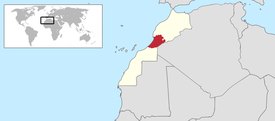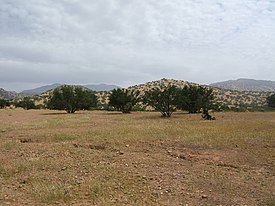
Berbers, or the Berber peoples, also known as Amazigh or Imazighen, are a diverse grouping of distinct ethnic groups indigenous to North Africa who predate the arrival of Arabs in the Maghreb. Their main connections are identified by their usage of Berber languages, most of them mutually unintelligible, which are part of the Afroasiatic language family.

Agadir is a major city in Morocco, on the shore of the Atlantic Ocean near the foot of the Atlas Mountains, just north of the point where the Souss River flows into the ocean, and 509 kilometres (316 mi) south of Casablanca. Agadir is the capital of the Agadir Ida-U-Tanan Prefecture and of the Souss-Massa economic region.

Ifriqiya, also known as al-Maghrib al-Adna, was a medieval historical region comprising today's Tunisia, eastern Algeria, and Tripolitania. It included all of what had previously been the Byzantine province of Africa Proconsularis and extended beyond it, but did not include the Mauretanias.

The Barghawatas were a Berber tribal confederation on the Atlantic coast of Morocco, belonging to the Masmuda confederacy. After allying with the Sufri Kharijite rebellion in Morocco against the Umayyad Caliphate, they established an independent state in the area of Tamesna on the Atlantic coast between Safi and Salé under the leadership of Tarif al-Matghari.

The Banu Hilal was a confederation of Arab tribes from the Najd region of the central Arabian Peninsula that emigrated to the Maghreb region of North Africa in the 11th century. Masters of the vast plateaux of the Najd, they enjoyed a somewhat infamous reputation, possibly owing to their relatively late conversion to Islam and accounts of their campaigns in the borderlands between Iraq and Syria. When the Fatimid Caliphate became the rulers of Egypt and the founders of Cairo in 969, they hastened to confine the unruly Bedouin in the south before sending them to Central North Africa and then to Morocco.

Judeo-Berber also known as Judeo-Amazigh, Judeo-Tamazight, and Jewish Amazigh is any of several hybrid Berber dialects traditionally spoken as a second language in Berber Jewish communities of central and southern Morocco, and perhaps earlier in Algeria. Judeo-Berber is a contact language; the first language of speakers was Judeo-Arabic. Speakers immigrated to Israel in the 1950s and 1960s. While mutually comprehensible with the Tamazight spoken by most inhabitants of the area, these varieties are distinguished by the use of Hebrew loanwords and the pronunciation of š as s as seen in Judeo-Moroccan Arabic.
The Zenata are a group of Berber tribes, historically one of the largest Berber confederations along with the Sanhaja and Masmuda. Their lifestyle was either nomadic or semi-nomadic.
The Miknasa was a Zenata Berber tribe of the Maghreb.
The Maghrawa or Meghrawa were a large Berber tribal confederation in North Africa. They were the largest branch of the Zenata confederation. Their traditional territories around the time of Muslim expansion into the Maghreb in the 7th century were around present-day northeastern Algeria. They ruled parts of the western Maghreb on behalf of the Umayyad Caliphate of Cordoba at the end of the 10th century and during the first half of the 11th century.

The Idrisid dynasty or Idrisids were an Arab Muslim dynasty from 788 to 974, ruling most of present-day Morocco and parts of present-day western Algeria. Named after the founder, Idris I, the Idrisids were an Alid dynasty descended from Muhammad through his grandson Hasan. The Idrisids are traditionally considered to be the founders of the first Moroccan state, setting the stage for subsequent dynasties and states centered in this region. Their reign played an important role in the early Islamization of Morocco and also presided over an increase in Arab immigration and Arabization in major urban centers.

ʿUqba ibn Nāfiʿ ibn ʿAbd al-Qays al-Fihrī al-Qurashī, also simply known as Uqba ibn Nafi, was an Arab general serving the Rashidun Caliphate since the reign of Umar and later the Umayyad Caliphate during the reigns of Mu'awiya I and Yazid I, leading the Muslim conquest of the Maghreb, including present-day Libya, Tunisia, Algeria and Morocco and a failed attempt in Nubia. He is credited with establishing Umayyad rule in North Africa. Uqba was the nephew of Amr ibn al-As. He is often surnamed al-Fihri in reference to the Banu Fihr, a clan connected to the Quraysh. His descendants would be known as the ʿUqbids or Fihrids.

Muhammad bin Ali al-Hawzali is the most important author in the literary tradition of the Tachelhit language. He was born around 1680 in the village of al-Qaṣaba (Elqeṣba) in tribal territory of the Induzal, in the region of Sous in Morocco and died in 1749.

Kusaila ibn Malzam, also known as Aksel, was a 7th-century Berber Christian ruler of the kingdom of Altava and leader of the Awraba tribe, a Christianised sedentary Berber tribe of the Aures and possibly Christian king of the Sanhaja. Under his rule his domain stretched from Volubilis in the west to the Aurès in the east and later Kairouan and the interior of Ifriqiya. Kusaila is mostly known for prosecuting an effective Berber military resistance against the Muslim conquest of the Maghreb in the 680s. He died in one of those battles in 688.
Hassan ibn al-Nu'man al-Ghassani was an Arab general of the Umayyad Caliphate who led the final Muslim conquest of Ifriqiya, firmly establishing Islamic rule in the region. Appointed by Caliph Abd al-Malik, Hassan launched a series of campaigns during the closing years of the 7th century, during which he defeated the Byzantines and the Berbers led by al-Kahina. The Byzantine capital of Carthage was destroyed in 698 and the nearby city of Tunis was founded in the following year. In Kairouan, Hassan set up a Muslim administration for the province to collect taxes from its Christian inhabitants and pay the troops. He enrolled thousands of Berbers into the army, which proved critical to later Muslim military successes in the Maghreb and the Iberian Peninsula. He was ultimately ousted from his post by the governor of Egypt, Abd al-Aziz ibn Marwan, due to a power struggle for influence over Ifriqiya.
The Banu Ifran or Ifranids, were a Zenata Berber tribe prominent in the history of pre-Islamic and early Islamic North Africa. In the 8th century, they established a kingdom in the central Maghreb, with Tlemcen as its capital.
Mohammed al-Mokhtar Soussi was a Moroccan Berber scholar, politician and writer who played an important role in the years before Morocco's independence in 1956. Born in the village of Illigh, he was a soufi and an expert on the history of the Sous region and the founder of a school in Marrakesh. From 1956 to 1963 he was minister of religious affairs and member of the Crown Council in the government of Mohammed V.

Zuhayr ibn Qays al-Balawī was a companion of the Islamic prophet Muhammad and an Arab commander who fought in the service of the Rashidun, Umayyad and Zubayrid caliphs. He played a key role in the early Muslim conquests of Egypt, Barqa (Cyrenaica) and Ifriqiya. When the latter province fell to a Byzantine–Berber alliance in 682, Zuhayr was given command of the army to restore Arab rule. During that campaign, he temporarily retook Kairouan, the Arabs' capital in Ifriqiya, and killed the Berber chief Kasila, but was slain by Byzantine raiders on his way back to Barqa.
The Aurès Mountains are located in northeastern Algeria and are part of the Saharan Atlas in the Maghreb region of Northwest Africa. The indigenous inhabitants of the Aurès are the Chaoui people, who are part of the broader Berber (Amazigh) community. The history of the Aurès dates back to prehistoric times.
Berber tribes are tribes of Berber descent inhabiting the Maghreb region. They are traditionally divided into three large tribal confederations: Masmuda, Zenata and Sanhaja. They often form smaller confederations of tribes together. Medieval historian Ibn Khaldun and other medieval genealogists also categorised Berber tribes into either the Baranis or Butr to refer to whether they were sedentary or nomadic.
Ibn Tunart or Ibn Tunirt, whose full name was Abu Abdullah Muhammad ibn Ja'far al-Qaysi, was born in 1085 in the Qal'at Bani Ḥammad. He studied in Béjaïa then in Cordoba. He later became a teacher and judge in Fez. He died in the same city in 1172.













